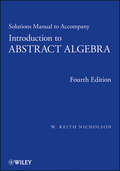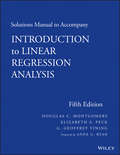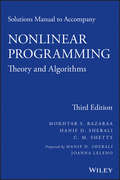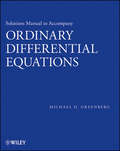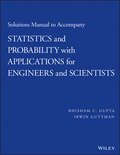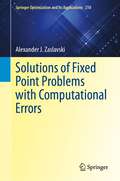- Table View
- List View
Solutions Manual to Accompany Geometry of Convex Sets
by I. E. Leonard J. E. LewisA Solutions Manual to accompany Geometry of Convex Sets Geometry of Convex Sets begins with basic definitions of the concepts of vector addition and scalar multiplication and then defines the notion of convexity for subsets of n-dimensional space. Many properties of convex sets can be discovered using just the linear structure. However, for more interesting results, it is necessary to introduce the notion of distance in order to discuss open sets, closed sets, bounded sets, and compact sets. The book illustrates the interplay between these linear and topological concepts, which makes the notion of convexity so interesting.Thoroughly class-tested, the book discusses topology and convexity in the context of normed linear spaces, specifically with a norm topology on an n-dimensional space.Geometry of Convex Sets also features: An introduction to n-dimensional geometry including points; lines; vectors; distance; norms; inner products; orthogonality; convexity; hyperplanes; and linear functionals Coverage of n-dimensional norm topology including interior points and open sets; accumulation points and closed sets; boundary points and closed sets; compact subsets of n-dimensional space; completeness of n-dimensional space; sequences; equivalent norms; distance between sets; and support hyperplanes · Basic properties of convex sets; convex hulls; interior and closure of convex sets; closed convex hulls; accessibility lemma; regularity of convex sets; affine hulls; flats or affine subspaces; affine basis theorem; separation theorems; extreme points of convex sets; supporting hyperplanes and extreme points; existence of extreme points; Krein–Milman theorem; polyhedral sets and polytopes; and Birkhoff’s theorem on doubly stochastic matrices Discussions of Helly’s theorem; the Art Gallery theorem; Vincensini’s problem; Hadwiger’s theorems; theorems of Radon and Caratheodory; Kirchberger’s theorem; Helly-type theorems for circles; covering problems; piercing problems; sets of constant width; Reuleaux triangles; Barbier’s theorem; and Borsuk’s problem Geometry of Convex Sets is a useful textbook for upper-undergraduate level courses in geometry of convex sets and is essential for graduate-level courses in convex analysis. An excellent reference for academics and readers interested in learning the various applications of convex geometry, the book is also appropriate for teachers who would like to convey a better understanding and appreciation of the field to students.I. E. Leonard, PhD, was a contract lecturer in the Department of Mathematical and Statistical Sciences at the University of Alberta. The author of over 15 peer-reviewed journal articles, he is a technical editor for the Canadian Applied Mathematical Quarterly journal.J. E. Lewis, PhD, is Professor Emeritus in the Department of Mathematical Sciences at the University of Alberta. He was the recipient of the Faculty of Science Award for Excellence in Teaching in 2004 as well as the PIMS Education Prize in 2002.
Solutions Manual to accompany Introduction to Abstract Algebra, 4e, Solutions Manual
by W. Keith NicholsonAn indispensable companion to the book hailed an "expository masterpiece of the highest didactic value" by Zentralblatt MATH This solutions manual helps readers test and reinforce the understanding of the principles and real-world applications of abstract algebra gained from their reading of the critically acclaimed Introduction to Abstract Algebra. Ideal for students, as well as engineers, computer scientists, and applied mathematicians interested in the subject, it provides a wealth of concrete examples of induction, number theory, integers modulo n, and permutations. Worked examples and real-world problems help ensure a complete understanding of the subject, regardless of a reader's background in mathematics.
Solutions Manual to accompany Introduction to Abstract Algebra, 4e, Solutions Manual
by W. Keith NicholsonAn indispensable companion to the book hailed an "expository masterpiece of the highest didactic value" by Zentralblatt MATH This solutions manual helps readers test and reinforce the understanding of the principles and real-world applications of abstract algebra gained from their reading of the critically acclaimed Introduction to Abstract Algebra. Ideal for students, as well as engineers, computer scientists, and applied mathematicians interested in the subject, it provides a wealth of concrete examples of induction, number theory, integers modulo n, and permutations. Worked examples and real-world problems help ensure a complete understanding of the subject, regardless of a reader's background in mathematics.
Solutions Manual to accompany Introduction to Linear Regression Analysis (Wiley Series In Probability And Statistics Ser. #821)
by Douglas C. Montgomery Elizabeth A. Peck G. Geoffrey ViningAs the Solutions Manual, this book is meant to accompany the main title, Introduction to Linear Regression Analysis, Fifth Edition. Clearly balancing theory with applications, this book describes both the conventional and less common uses of linear regression in the practical context of today's mathematical and scientific research. Beginning with a general introduction to regression modeling, including typical applications, the book then outlines a host of technical tools that form the linear regression analytical arsenal, including: basic inference procedures and introductory aspects of model adequacy checking; how transformations and weighted least squares can be used to resolve problems of model inadequacy; how to deal with influential observations; and polynomial regression models and their variations. The book also includes material on regression models with autocorrelated errors, bootstrapping regression estimates, classification and regression trees, and regression model validation.
Solutions Manual to accompany Introduction to Linear Regression Analysis
by Douglas C. Montgomery Elizabeth A. Peck G. Geoffrey ViningAs the Solutions Manual, this book is meant to accompany the main title, Introduction to Linear Regression Analysis, Fifth Edition. Clearly balancing theory with applications, this book describes both the conventional and less common uses of linear regression in the practical context of today's mathematical and scientific research. Beginning with a general introduction to regression modeling, including typical applications, the book then outlines a host of technical tools that form the linear regression analytical arsenal, including: basic inference procedures and introductory aspects of model adequacy checking; how transformations and weighted least squares can be used to resolve problems of model inadequacy; how to deal with influential observations; and polynomial regression models and their variations. The book also includes material on regression models with autocorrelated errors, bootstrapping regression estimates, classification and regression trees, and regression model validation.
Solutions Manual to accompany Introduction to Linear Regression Analysis
by Douglas C. Montgomery Elizabeth A. Peck G. Geoffrey ViningINTRODUCTION TO LINEAR REGRESSION ANALYSIS
Solutions Manual to accompany Introduction to Linear Regression Analysis
by Douglas C. Montgomery Elizabeth A. Peck G. Geoffrey ViningINTRODUCTION TO LINEAR REGRESSION ANALYSIS
Solutions Manual to accompany An Introduction to Numerical Methods and Analysis
by James F. EppersonA solutions manual to accompany An Introduction to Numerical Methods and Analysis, Second Edition An Introduction to Numerical Methods and Analysis, Second Edition reflects the latest trends in the field, includes new material and revised exercises, and offers a unique emphasis on applications. The author clearly explains how to both construct and evaluate approximations for accuracy and performance, which are key skills in a variety of fields. A wide range of higher-level methods and solutions, including new topics such as the roots of polynomials, spectral collocation, finite element ideas, and Clenshaw-Curtis quadrature, are presented from an introductory perspective, and theSecond Edition also features: Chapters and sections that begin with basic, elementary material followed by gradual coverage of more advanced material Exercises ranging from simple hand computations to challenging derivations and minor proofs to programming exercises Widespread exposure and utilization of MATLAB® An appendix that contains proofs of various theorems and other material
Solutions Manual to accompany An Introduction to Numerical Methods and Analysis
by James F. EppersonA solutions manual to accompany An Introduction to Numerical Methods and Analysis, Second Edition An Introduction to Numerical Methods and Analysis, Second Edition reflects the latest trends in the field, includes new material and revised exercises, and offers a unique emphasis on applications. The author clearly explains how to both construct and evaluate approximations for accuracy and performance, which are key skills in a variety of fields. A wide range of higher-level methods and solutions, including new topics such as the roots of polynomials, spectral collocation, finite element ideas, and Clenshaw-Curtis quadrature, are presented from an introductory perspective, and theSecond Edition also features: Chapters and sections that begin with basic, elementary material followed by gradual coverage of more advanced material Exercises ranging from simple hand computations to challenging derivations and minor proofs to programming exercises Widespread exposure and utilization of MATLAB® An appendix that contains proofs of various theorems and other material
Solutions Manual to Accompany An Introduction to Numerical Methods and Analysis
by James F. EppersonA solutions manual to accompany An Introduction to Numerical Methods and Analysis, Third Edition An Introduction to Numerical Methods and Analysis helps students gain a solid understanding of a wide range of numerical approximation methods for solving problems of mathematical analysis. Designed for entry-level courses on the subject, this popular textbook maximizes teaching flexibility by first covering basic topics before gradually moving to more advanced material in each chapter and section. Throughout the text, students are provided clear and accessible guidance on a wide range of numerical methods and analysis techniques, including root-finding, numerical integration, interpolation, solution of systems of equations, and many others. This fully revised third edition contains new sections on higher-order difference methods, the bisection and inertia method for computing eigenvalues of a symmetric matrix, a completely re-written section on different methods for Poisson equations, and spectral methods for higher-dimensional problems. New problem sets—ranging in difficulty from simple computations to challenging derivations and proofs—are complemented by computer programming exercises, illustrative examples, and sample code. This acclaimed textbook: Explains how to both construct and evaluate approximations for accuracy and performance Covers both elementary concepts and tools and higher-level methods and solutions Features new and updated material reflecting new trends and applications in the field Contains an introduction to key concepts, a calculus review, an updated primer on computer arithmetic, a brief history of scientific computing, a survey of computer languages and software, and a revised literature review Includes an appendix of proofs of selected theorems and author-hosted companion website with additional exercises, application models, and supplemental resources
Solutions Manual to Accompany An Introduction to Numerical Methods and Analysis
by James F. EppersonA solutions manual to accompany An Introduction to Numerical Methods and Analysis, Third Edition An Introduction to Numerical Methods and Analysis helps students gain a solid understanding of a wide range of numerical approximation methods for solving problems of mathematical analysis. Designed for entry-level courses on the subject, this popular textbook maximizes teaching flexibility by first covering basic topics before gradually moving to more advanced material in each chapter and section. Throughout the text, students are provided clear and accessible guidance on a wide range of numerical methods and analysis techniques, including root-finding, numerical integration, interpolation, solution of systems of equations, and many others. This fully revised third edition contains new sections on higher-order difference methods, the bisection and inertia method for computing eigenvalues of a symmetric matrix, a completely re-written section on different methods for Poisson equations, and spectral methods for higher-dimensional problems. New problem sets—ranging in difficulty from simple computations to challenging derivations and proofs—are complemented by computer programming exercises, illustrative examples, and sample code. This acclaimed textbook: Explains how to both construct and evaluate approximations for accuracy and performance Covers both elementary concepts and tools and higher-level methods and solutions Features new and updated material reflecting new trends and applications in the field Contains an introduction to key concepts, a calculus review, an updated primer on computer arithmetic, a brief history of scientific computing, a survey of computer languages and software, and a revised literature review Includes an appendix of proofs of selected theorems and author-hosted companion website with additional exercises, application models, and supplemental resources
Solutions Manual to Accompany Introduction to Quantitative Methods in Business: with Applications Using Microsoft Office Excel
by Bharat Kolluri Michael J. Panik Rao N. SingamsettiSolutions Manual to accompany Introduction to Quantitative Methods in Business: With Applications Using Microsoft Office Excel
Solutions Manual to Accompany Introduction to Quantitative Methods in Business: with Applications Using Microsoft Office Excel
by Bharat Kolluri Michael J. Panik Rao N. SingamsettiSolutions Manual to accompany Introduction to Quantitative Methods in Business: With Applications Using Microsoft Office Excel
Solutions Manual to Accompany Linear Algebra: Ideas and Applications
by Richard C. PenneyThis Student Solutions Manual to Accompany Linear Algebra: Ideas and Applications, Fourth Edition contains solutions to the odd numbered problems to further aid in reader comprehension, and an Instructor's Solutions Manual (inclusive of suggested syllabi) is available via written request to the Publisher. Both the Student and Instructor Manuals have been enhanced with further discussions of the applications sections, which is ideal for readers who wish to obtain a deeper knowledge than that provided by pure algorithmic approaches. Linear Algebra: Ideas and Applications, Fourth Edition provides a unified introduction to linear algebra while reinforcing and emphasizing a conceptual and hands-on understanding of the essential ideas. Promoting the development of intuition rather than the simple application of methods, this book successfully helps readers to understand not only how to implement a technique, but why its use is important.
Solutions Manual to Accompany Linear Algebra: Ideas and Applications
by Richard C. PenneyThis Student Solutions Manual to Accompany Linear Algebra: Ideas and Applications, Fourth Edition contains solutions to the odd numbered problems to further aid in reader comprehension, and an Instructor's Solutions Manual (inclusive of suggested syllabi) is available via written request to the Publisher. Both the Student and Instructor Manuals have been enhanced with further discussions of the applications sections, which is ideal for readers who wish to obtain a deeper knowledge than that provided by pure algorithmic approaches. Linear Algebra: Ideas and Applications, Fourth Edition provides a unified introduction to linear algebra while reinforcing and emphasizing a conceptual and hands-on understanding of the essential ideas. Promoting the development of intuition rather than the simple application of methods, this book successfully helps readers to understand not only how to implement a technique, but why its use is important.
Solutions Manual to Accompany Models for Life: An Introduction to Discrete Mathematical Modeling with Microsoft Office Excel
by Jeffrey T. BartonA solutions manual to accompany An Introduction to Discrete Mathematical Modeling with Microsoft® Office Excel® With a focus on mathematical models based on real and current data, Models for Life: An Introduction to Discrete Mathematical Modeling with Microsoft® Office Excel® guides readers in the solution of relevant, practical problems by introducing both mathematical and Excel techniques. The book begins with a step-by-step introduction to discrete dynamical systems, which are mathematical models that describe how a quantity changes from one point in time to the next. Readers are taken through the process, language, and notation required for the construction of such models as well as their implementation in Excel. The book examines single-compartment models in contexts such as population growth, personal finance, and body weight and provides an introduction to more advanced, multi-compartment models via applications in many areas, including military combat, infectious disease epidemics, and ranking methods. Models for Life: An Introduction to Discrete Mathematical Modeling with Microsoft® Office Excel® also features: A modular organization that, after the first chapter, allows readers to explore chapters in any order Numerous practical examples and exercises that enable readers to personalize the presented models by using their own data Carefully selected real-world applications that motivate the mathematical material such as predicting blood alcohol concentration, ranking sports teams, and tracking credit card debt References throughout the book to disciplinary research on which the presented models and model parameters are based in order to provide authenticity and resources for further study Relevant Excel concepts with step-by-step guidance, including screenshots to help readers better understand the presented material Both mathematical and graphical techniques for understanding concepts such as equilibrium values, fixed points, disease endemicity, maximum sustainable yield, and a drug’s therapeutic window A companion website that includes the referenced Excel spreadsheets, select solutions to homework problems, and an instructor’s manual with solutions to all homework problems, project ideas, and a test bank
Solutions Manual to Accompany Models for Life: An Introduction to Discrete Mathematical Modeling with Microsoft Office Excel
by Jeffrey T. BartonA solutions manual to accompany An Introduction to Discrete Mathematical Modeling with Microsoft® Office Excel® With a focus on mathematical models based on real and current data, Models for Life: An Introduction to Discrete Mathematical Modeling with Microsoft® Office Excel® guides readers in the solution of relevant, practical problems by introducing both mathematical and Excel techniques. The book begins with a step-by-step introduction to discrete dynamical systems, which are mathematical models that describe how a quantity changes from one point in time to the next. Readers are taken through the process, language, and notation required for the construction of such models as well as their implementation in Excel. The book examines single-compartment models in contexts such as population growth, personal finance, and body weight and provides an introduction to more advanced, multi-compartment models via applications in many areas, including military combat, infectious disease epidemics, and ranking methods. Models for Life: An Introduction to Discrete Mathematical Modeling with Microsoft® Office Excel® also features: A modular organization that, after the first chapter, allows readers to explore chapters in any order Numerous practical examples and exercises that enable readers to personalize the presented models by using their own data Carefully selected real-world applications that motivate the mathematical material such as predicting blood alcohol concentration, ranking sports teams, and tracking credit card debt References throughout the book to disciplinary research on which the presented models and model parameters are based in order to provide authenticity and resources for further study Relevant Excel concepts with step-by-step guidance, including screenshots to help readers better understand the presented material Both mathematical and graphical techniques for understanding concepts such as equilibrium values, fixed points, disease endemicity, maximum sustainable yield, and a drug’s therapeutic window A companion website that includes the referenced Excel spreadsheets, select solutions to homework problems, and an instructor’s manual with solutions to all homework problems, project ideas, and a test bank
Solutions Manual to accompany Modern Engineering Statistics
by Thomas P. RyanAn introductory perspective on statistical applications in the field of engineering Modern Engineering Statistics presents state-of-the-art statistical methodology germane to engineering applications. With a nice blend of methodology and applications, this book provides and carefully explains the concepts necessary for students to fully grasp and appreciate contemporary statistical techniques in the context of engineering. With almost thirty years of teaching experience, many of which were spent teaching engineering statistics courses, the author has successfully developed a book that displays modern statistical techniques and provides effective tools for student use. This book features: Examples demonstrating the use of statistical thinking and methodology for practicing engineers A large number of chapter exercises that provide the opportunity for readers to solve engineering-related problems, often using real data sets Clear illustrations of the relationship between hypothesis tests and confidence intervals Extensive use of Minitab and JMP to illustrate statistical analyses The book is written in an engaging style that interconnects and builds on discussions, examples, and methods as readers progress from chapter to chapter. The assumptions on which the methodology is based are stated and tested in applications. Each chapter concludes with a summary highlighting the key points that are needed in order to advance in the text, as well as a list of references for further reading. Certain chapters that contain more than a few methods also provide end-of-chapter guidelines on the proper selection and use of those methods. Bridging the gap between statistics education and real-world applications, Modern Engineering Statistics is ideal for either a one- or two-semester course in engineering statistics.
Solutions Manual to accompany Nonlinear Programming: Theory and Algorithms
by Mokhtar S. Bazaraa Hanif D. Sherali C. M. ShettyAs the Solutions Manual, this book is meant to accompany the main title, Nonlinear Programming: Theory and Algorithms, Third Edition. This book presents recent developments of key topics in nonlinear programming (NLP) using a logical and self-contained format. The volume is divided into three sections: convex analysis, optimality conditions, and dual computational techniques. Precise statements of algortihms are given along with convergence analysis. Each chapter contains detailed numerical examples, graphical illustrations, and numerous exercises to aid readers in understanding the concepts and methods discussed.
Solutions Manual to accompany Nonlinear Programming: Theory and Algorithms
by Mokhtar S. Bazaraa Hanif D. Sherali C. M. ShettyAs the Solutions Manual, this book is meant to accompany the main title, Nonlinear Programming: Theory and Algorithms, Third Edition. This book presents recent developments of key topics in nonlinear programming (NLP) using a logical and self-contained format. The volume is divided into three sections: convex analysis, optimality conditions, and dual computational techniques. Precise statements of algortihms are given along with convergence analysis. Each chapter contains detailed numerical examples, graphical illustrations, and numerous exercises to aid readers in understanding the concepts and methods discussed.
Solutions Manual to accompany Ordinary Differential Equations
by Michael D. GreenbergFeatures a balance between theory, proofs, and examples and provides applications across diverse fields of study Ordinary Differential Equations presents a thorough discussion of first-order differential equations and progresses to equations of higher order.
Solutions Manual to accompany Ordinary Differential Equations
by Michael D. GreenbergFeatures a balance between theory, proofs, and examples and provides applications across diverse fields of study Ordinary Differential Equations presents a thorough discussion of first-order differential equations and progresses to equations of higher order.
Solutions Manual to Accompany Statistics and Probability with Applications for Engineers and Scientists
by Bhisham C. Gupta Irwin GuttmanA solutions manual to accompany Statistics and Probability with Applications for Engineers and Scientists Unique among books of this kind, Statistics and Probability with Applications for Engineers and Scientists covers descriptive statistics first, then goes on to discuss the fundamentals of probability theory. Along with case studies, examples, and real-world data sets, the book incorporates clear instructions on how to use the statistical packages Minitab® and Microsoft® Office Excel® to analyze various data sets. The book also features: Detailed discussions on sampling distributions, statistical estimation of population parameters, hypothesis testing, reliability theory, statistical quality control including Phase I and Phase II control charts, and process capability indices A clear presentation of nonparametric methods and simple and multiple linear regression methods, as well as a brief discussion on logistic regression method Comprehensive guidance on the design of experiments, including randomized block designs, one- and two-way layout designs, Latin square designs, random effects and mixed effects models, factorial and fractional factorial designs, and response surface methodology A companion website containing data sets for Minitab and Microsoft Office Excel, as well as JMP ® routines and results Assuming no background in probability and statistics, Statistics and Probability with Applications for Engineers and Scientists features a unique, yet tried-and-true, approach that is ideal for all undergraduate students as well as statistical practitioners who analyze and illustrate real-world data in engineering and the natural sciences.
Solutions of Fixed Point Problems with Computational Errors (Springer Optimization and Its Applications #210)
by Alexander J. ZaslavskiThe book is devoted to the study of approximate solutions of fixed point problems in the presence of computational errors. It begins with a study of approximate solutions of star-shaped feasibility problems in the presence of perturbations. The goal is to show the convergence of algorithms, which are known as important tools for solving convex feasibility problems and common fixed point problems.The text also presents studies of algorithms based on unions of nonexpansive maps, inconsistent convex feasibility problems, and split common fixed point problems. A number of algorithms are considered for solving convex feasibility problems and common fixed point problems. The book will be of interest for researchers and engineers working in optimization, numerical analysis, and fixed point theory. It also can be useful in preparation courses for graduate students. The main feature of the book which appeals specifically to this audience is the study of the influence of computational errorsfor several important algorithms used for nonconvex feasibility problems.
Solutions of Nonlinear Schrӧdinger Systems (Springer Theses)
by Zhijie ChenThe existence and qualitative properties of nontrivial solutions for some important nonlinear Schrӧdinger systems have been studied in this thesis. For a well-known system arising from nonlinear optics and Bose-Einstein condensates (BEC), in the subcritical case, qualitative properties of ground state solutions, including an optimal parameter range for the existence, the uniqueness and asymptotic behaviors, have been investigated and the results could firstly partially answer open questions raised by Ambrosetti, Colorado and Sirakov. In the critical case, a systematical research on ground state solutions, including the existence, the nonexistence, the uniqueness and the phase separation phenomena of the limit profile has been presented, which seems to be the first contribution for BEC in the critical case. Furthermore, some quite different phenomena were also studied in a more general critical system. For the classical Brezis-Nirenberg critical exponent problem, the sharp energy estimate of least energy solutions in a ball has been investigated in this study. Finally, for Ambrosetti type linearly coupled Schrӧdinger equations with critical exponent, an optimal result on the existence and nonexistence of ground state solutions for different coupling constants was also obtained in this thesis. These results have many applications in Physics and PDEs.

